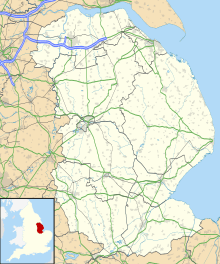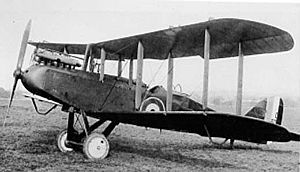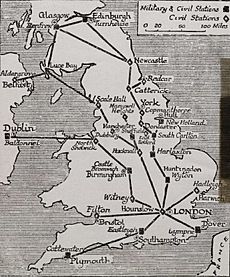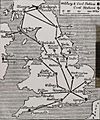RAF Harlaxton facts for kids
Quick facts for kids
|
|||||||||||||||||||
|---|---|---|---|---|---|---|---|---|---|---|---|---|---|---|---|---|---|---|---|
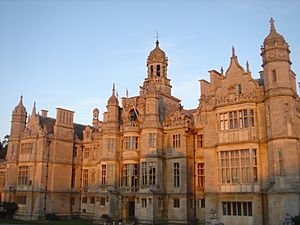
Harlaxton Manor was requisitioned by the RAF during the Second World War as the station's officers' mess.
|
|||||||||||||||||||
| Summary | |||||||||||||||||||
| Airport type | Military | ||||||||||||||||||
| Operator | Royal Flying Corps Royal Air Force |
||||||||||||||||||
| Location | Harlaxton, Lincolnshire, England | ||||||||||||||||||
| Built | 1916 | ||||||||||||||||||
| In use | 41 years | ||||||||||||||||||
| Elevation AMSL | 200 ft / 61 m | ||||||||||||||||||
| Coordinates | 52°52′46″N 000°39′33″W / 52.87944°N 0.65917°W | ||||||||||||||||||
| Map | |||||||||||||||||||
| Runway | |||||||||||||||||||
|
|||||||||||||||||||
|
Operated as a satellite unit of RAF Spitalgate and later RAF Cranwell. Decommissioned and closed in 1957
Flying training establishment and later a relief landing ground for RAF Grantham (RAF Spitalgate) |
|||||||||||||||||||
RAF Harlaxton was a former Royal Air Force (RAF) station, which is like a military airport, located near the village of Harlaxton in England. It was about 3 miles (4.8 km) southwest of Grantham, in Lincolnshire. The airfield was built on flat fields between Harlaxton Manor and the village of Stroxton.
It first opened in November 1916 as an airfield for the Royal Flying Corps (RFC), which was the air force before the RAF. It closed down for a while after the First World War. Then, it reopened in 1942 as an RAF training base during the Second World War. It finally closed for good in 1957. During the Second World War, Harlaxton Manor was used by the RAF as a place for officers to live and work. It also temporarily housed the headquarters for the 1st Airborne Division.
Contents
History of the Airfield
The airfield started in November 1916 as a training base for the Royal Flying Corps. It had three grass runways shaped like a triangle. During the First World War, many planes were based there for training, including different types of de Havilland aircraft and Sopwith Camels.
A group called No. 98 Squadron RAF was formed at Harlaxton. After training, they went to France to fly DH.9 planes for bombing missions during the day.
After the First World War, from 1919, some civilian flights also used the airfield.
Reopening for World War II
The station was put on "care and maintenance" between the wars, meaning it was kept ready but not actively used. In 1937, people looked at it to see if it could be a fighter airfield to protect cities like Nottingham and Leicester. However, the ground wasn't suitable for paved runways, so the grass runways stayed. A lot of new buildings were added.
In 1942, RAF Harlaxton reopened. It became a "satellite field" and "relief landing ground" for a flying training squadron from RAF Spitalgate in Grantham. This meant it was a smaller base used to support the main one, and planes could land there if they couldn't land at Spitalgate.
Harlaxton Manor was taken over by the military and used as the officers' mess, a place where the officers ate and relaxed. Before D-Day, which was a very important invasion during World War II, the manor also hosted the headquarters of the British Army's 1st Airborne Division as they planned their missions.
Closure of the Base
As World War II ended, RAF Harlaxton continued to be a support base, this time for the training facility at RAF Cranwell. In the mid-1950s, Cranwell started using jet aircraft for training. Jet planes need strong, paved runways, which Harlaxton's grass runways were not. Because of this, RAF Harlaxton finally closed in 1957.
Cold War Role
During the Second World War, a Royal Observer Corps post was located near the airfield. Their job was to spot enemy aircraft and warn the Grantham area about air raids. In the 1960s, during the Cold War, an underground nuclear bunker was built on the same site. This bunker was used until 1991 when the Royal Observer Corps was no longer needed. The bunker is now empty and damaged by vandals.
Incidents at Harlaxton
On 29 January 1945, a USAAF Douglas C-47 Skytrain transport plane tried to make an emergency landing at Harlaxton. The plane was badly damaged and couldn't be fixed, but luckily, the crew only had minor injuries and everyone survived.
British bomb disposal teams had trouble dealing with German 2-kilogram "butterfly bombs" because they couldn't safely take one apart to learn how it worked. While dealing with eight of these bombs that had fallen on RAF Harlaxton and not exploded, Flight Sergeant Hanford from RAF Bomb Disposal noticed that the bombs' safety rods hadn't fully come out. He carefully screwed them back in by hand. This allowed scientists to safely dismantle the bombs and learn how they worked, which helped with future bomb disposal. Hanford was later given the British Empire Medal for his incredible bravery.
The Airfield Today
Today, there isn't much left to see of the old airfield. The runways have been turned back into farmland. An old building from the airfield, called the M&E building, is now empty. However, you can still find the remains of an "Allen-Williams Turret," which was a rotating anti-aircraft gun position.
Unlike many other old airfields in Lincolnshire, there isn't a permanent memorial plaque at Harlaxton. The land is now owned by a company that has fixed up some of the old air raid shelters and the main building. They plan to put up a memorial soon.
Images for kids
See also
- List of former Royal Air Force stations
- RAF Spitalgate
- Harlaxton, Lincolnshire


